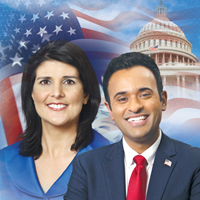The Growing Power of Indian-Americans in US Politics
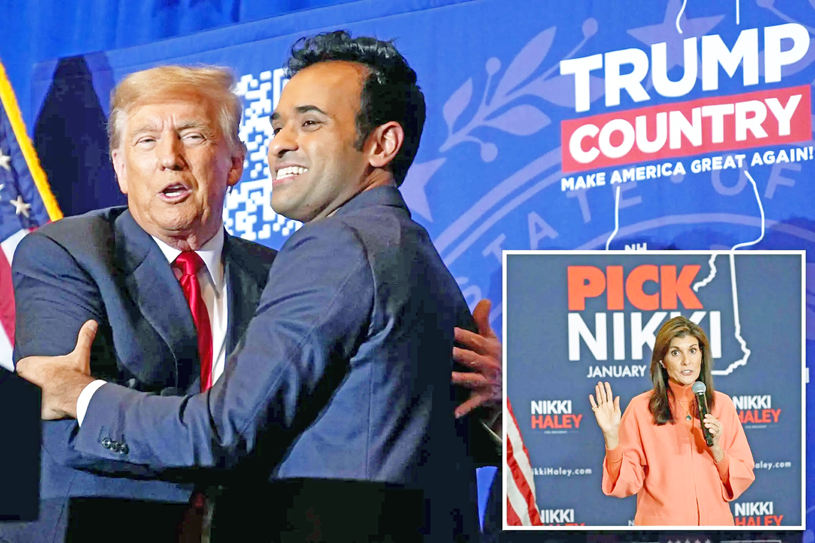
Over recent decades, the influence of Indian-Americans in the realm of U.S. politics has surged. We are witnessing the ascendance of a new force, Indian-Americans, taking center stage and showing their potential for leadership roles in US politics. While the community has always played an active role in various sectors, their notable prominence in political scenarios has spiked in recent years. The voices and visions of the vibrant community have begun to carve out a distinctive niche within the country’s political landscape, infusing it with a fresh, multicultural dynamism. This trend is embodied in the political journeys of two significant figures, Nikki Haley and Vivek Ramaswamy, both of whom have been instrumental in ushering in this new era of Indian-American political prowess. Both of their names are surfacing as possible vice presidential picks for Donald Trump in the 2024 race. Their leadership is emblematic of the broader pattern of Indian-Americans stepping into influential political roles, signaling an exciting evolution of diversity and representation within the American political scene. As the narratives of Haley and Ramaswamy illustrate, the Indian-American community is not just participating in U.S. politics but actively shaping its future trajectory.
Indian-Americans: The New Force in US Politics
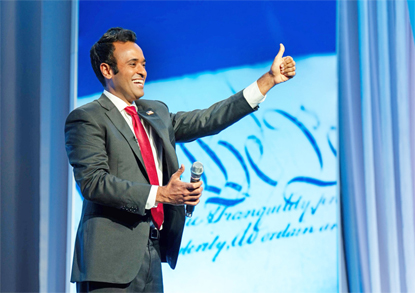 Stepping out of the shadows and into the political limelight, Indian-Americans have surged forward as a formidable power in American politics. Over the years, they have evolved from being passive observers to active participants, imprinting their influence from the corridors of local government to the grandeur of Congress. Their journey, though demanding, reflects the community’s determination and resilience.
Stepping out of the shadows and into the political limelight, Indian-Americans have surged forward as a formidable power in American politics. Over the years, they have evolved from being passive observers to active participants, imprinting their influence from the corridors of local government to the grandeur of Congress. Their journey, though demanding, reflects the community’s determination and resilience.
The 2016–2022 elections marked a pivotal moment for the community, as a record number of Indian-Americans emerged victorious, capturing as many as five esteemed seats in Congress. This electoral triumph was not just a display of political prowess; it also underlined the community’s mounting engagement and commitment to their adopted homeland.
Indian-Americans’ increased presence in politics is not just about acquiring seats or gaining authority; rather, it symbolizes a shift in the larger narrative. A narrative that sees them not merely as voters on the sidelines but as the ones in the driver’s seat, shaping policies and molding public opinion. This dynamic shift is nothing short of a revolution, and it signifies their transition from the margins to the mainstream.
The role of Indian-Americans in politics has not only diversified the spectrum of political leaders, but it has also propelled a broader, more inclusive representation of the American demographic. Their emergence and increased visibility have added more color to the American political canvas, weaving a tapestry that truly embodies the spirit of a multicultural America.
However, it is worth mentioning that the increased representation of Indian-Americans isn’t just about numbers; it’s also about the quality of their contribution. They’ve been critical in pushing for reforms and influencing policies that go beyond their community, proving that their influence is far-reaching and significant.
In a nutshell, Indian-Americans are not just a new force in US politics; they are a transformative force, changing the political discourse and reshaping the landscape. As we look to the future, it is clear that their role and influence will continue to grow, opening up new possibilities and charting new paths.
Indian-American Impact on Policy and Legislation
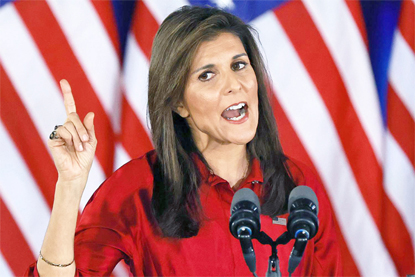 The surge in Indian-American influence is profoundly changing the face of U.S. policy-making and legislation. From state-level reforms to sparking nationwide debates, this dynamic community is leaving an indelible mark on American political discourse. A sterling example of this can be seen in Nikki Haley’s tenure as governor of South Carolina. As the state’s top executive, she pushed for notable tax reforms, proving her commitment to fiscal responsibility. Her work at the helm of the state government demonstrated the positive influence that Indian-American leaders can wield in formulating effective, citizen-centric policies.
The surge in Indian-American influence is profoundly changing the face of U.S. policy-making and legislation. From state-level reforms to sparking nationwide debates, this dynamic community is leaving an indelible mark on American political discourse. A sterling example of this can be seen in Nikki Haley’s tenure as governor of South Carolina. As the state’s top executive, she pushed for notable tax reforms, proving her commitment to fiscal responsibility. Her work at the helm of the state government demonstrated the positive influence that Indian-American leaders can wield in formulating effective, citizen-centric policies.
Parallelly, we see a non-traditional form of influence in Vivek Ramaswamy’s work. Even without holding a political office, his staunch advocacy for intellectual diversity and free speech has made ripples in policy discussions across the country. His keen insights and pointed critiques have challenged the status quo, compelling legislators, corporate leaders, and the public to consider and debate these pertinent issues.
Further evidence of the growing Indian-American influence can be observed in the increase of elected officials from this community at all levels of government, from local city councils to the hallowed halls of Congress. This uptick is not only a testament to their growing participation in the political process but also highlights their potential to influence legislation that reflects the unique interests and values of the Indian-American community. As they carve out a greater space for themselves in the U.S. political sphere, Indian-Americans are playing a pivotal role in shaping policies and legislation, thereby reaffirming the vitality of the American democratic ethos that celebrates diversity and inclusivity.
The Implications of Indian-Americans on the Political Stage
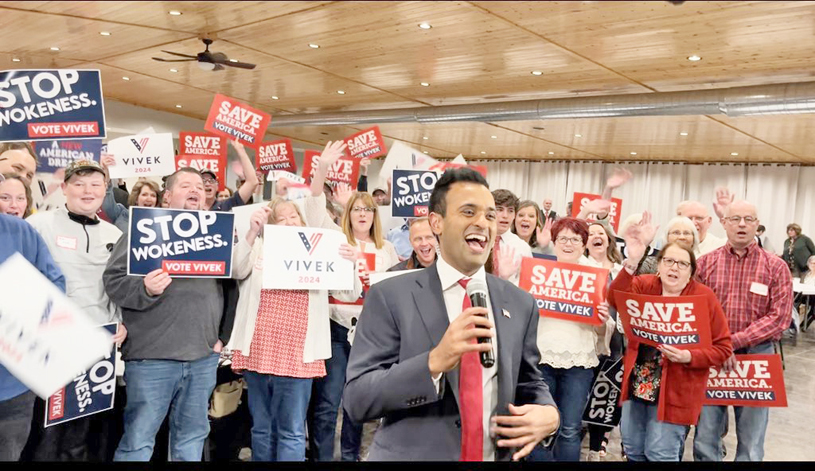
The increasing prominence of Indian-Americans in US politics is an empowering reflection of America’s evolving multicultural tapestry. It serves as a testament to America’s recognition of the significant talents and capacities within this community, which can greatly influence the future trajectory of the nation. High-ranking Indian-American politicians can play a pivotal role in crafting policies that further diversity and inclusion, thereby reshaping the face of American politics to be more reflective of its multifaceted demographic.
With India emerging as one of the fastest-growing global economies, strong Indian-American representation in US politics can also lead to fortified diplomatic ties between the two nations. Such diplomatic relationships could lead to more fruitful collaborations on various global issues such as climate change, technology innovation, and economic policies, reaping benefits not only for the two nations involved but also for the world at large.
Political participation by the Indian-American community emphasizes the essence of equal representation, demonstrating that their perspectives, ideas, and solutions hold weight in the political realm. It also sends a powerful message to other ethnic communities, inspiring them to contribute to the political discourse, thereby adding more voices to the narrative.
Additionally, having Indian-American representation in politics fosters a stronger connection and sense of belonging within the community. It paves the way for the younger generation to dream bigger, broadening their aspirations beyond traditional careers and inspiring them to consider public service and political leadership. This heightened sense of aspiration and representation in politics also plays a significant role in addressing issues specifically relevant to the community, providing them with a platform to voice their concerns, and ensuring they are part of the national dialogue.
In essence, the rising influence of Indian-Americans in US politics heralds a new era of diversity, inclusion, and broader representation. It not only enriches the American political landscape with fresh perspectives but also adds a potent layer of global connectivity in an increasingly interconnected world. As we continue to observe this shift, it’s exciting to consider the profound impact it could have on the future of American politics and beyond.
The Future of Indian-Americans in US Politics
As we turn our gaze toward the horizon, the prospects for Indian-Americans in the political sphere of the United States shine brightly. Pioneers such as Nikki Haley and Vivek Ramaswamy have blazed the trail, their stories serving as inspiring narratives for those ready to step onto the stage of U.S. politics. Their work has not only created space for increased representation, but it has also set an expectation of active and influential participation from the Indian-American community in shaping America’s political narrative.
Undoubtedly, the community has been quite successful in making its presence felt in the American political scenario. But to sustain this momentum and continue this wave of transformation, the Indian-American community must go beyond being just a powerful force and transform into a guiding beacon for future generations. Encouraging, grooming, and mentoring the younger generation to pursue careers in public service and political leadership is essential. The youthful energy and innovative thinking they bring can be a driving force in propelling the community’s influence further.
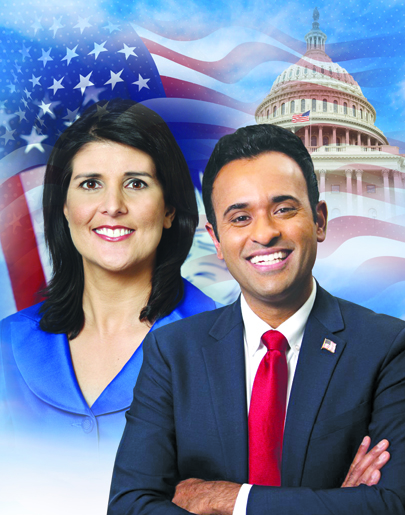 Building and maintaining political engagement is no small task. It’s a process that requires sustained effort, commitment, and active involvement. From local government offices to the hallowed halls of Congress, Indian-Americans need to continue to play an active role and make their voices heard at every level. This is not just about numbers or representation, but about ensuring the community’s ideas, perspectives, and solutions continue to shape and influence the political landscape.
Building and maintaining political engagement is no small task. It’s a process that requires sustained effort, commitment, and active involvement. From local government offices to the hallowed halls of Congress, Indian-Americans need to continue to play an active role and make their voices heard at every level. This is not just about numbers or representation, but about ensuring the community’s ideas, perspectives, and solutions continue to shape and influence the political landscape.
Another essential aspect of the road ahead is fostering a sense of unity and alliance with other communities. A crucial lesson from the political playbook is that there is strength in numbers. Building bridges with other communities, finding common ground on issues, and joining forces to address them can amplify the collective voice and make it harder to ignore. The Indian-American community can use its growing influence to lead these collaborative efforts, fostering a political climate of shared understanding and mutual respect.
In the end, the journey ahead is not just about the Indian-American community making its mark in American politics. It’s about continuing to contribute to the broader narrative of an inclusive and diverse America, where every voice matters, where every perspective is valued, and where the strength of the nation lies in its multicultural tapestry. The road may be long and the journey demanding, but the promise of what lies ahead makes it all worthwhile.
This new era of Indian-American participation in US politics is not just about representation; it’s about participation and creating a difference. It’s about proving that the American Dream is alive and well and that regardless of one’s heritage or background, anyone can rise to the highest echelons of power and contribute meaningfully to the country they call home.
The possibilities extend beyond simply running for office. Indian-Americans are poised to take up the mantle of leadership in myriad ways, influencing policy, driving conversations, and fostering a richer and more diverse political environment. The future promises an even greater imprint of the Indian-American community on American politics, injecting it with the dynamism of their unique cultural insights, perspectives, and vibrancy.
This isn’t just a positive sign for the Indian-American community, but a celebration of the strength of the American democratic system—one that values diversity, encourages plurality, and thrives on the inclusion of varied voices. The rise of Indian-Americans in U.S. politics underscores a future where cultural diversity and inclusive representation aren’t just tokens but key drivers of political discourse and decision-making.
As we chart the path forward, it’s clear that the growing influence of Indian-Americans in U.S. politics extends beyond mere representation. They’re not just on the sidelines; they’re taking the lead, shaping narratives, and influencing outcomes. As they continue to break barriers and redefine political landscapes, the Indian-American community stands poised to further invigorate U.S. politics with their distinctive contributions. For Indian-Americans, the future isn’t just promising; it’s already here.

